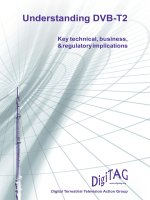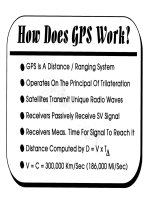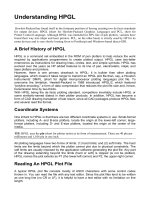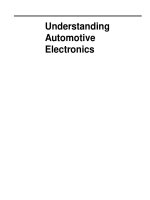- Trang chủ >>
- Khoa Học Tự Nhiên >>
- Vật lý
Understanding tourism
Bạn đang xem bản rút gọn của tài liệu. Xem và tải ngay bản đầy đủ của tài liệu tại đây (5.76 MB, 247 trang )
UNDERSTANDING TOURISM
By the same author
Britain - Workshop or Service Centre to the World?
The British Hotel and Catering Industry
The Business ofHotels
Dictionary ofTravel, Tourism and Hospitality
Europeans on Holiday
Higher Education and Research in Tourism in Western Europe
Historical Development of Tourism (with A.I. Burkart)
Holiday Surveys Examined
The Management of Tourism (with AJ. Burkarteds.)
Managing Tourism (ed.)
AManual ofHotel Reception (with I.R.S. Beavis)
Paying Guests
Profile ofthe Hotel and Catering Industry (with D.W. Airey)
Tourism and Productivity
Tourism Council ofthe South Pacific Corporate Plan
Tourism Employment in Wales
Tourism: Past, Present and Future (with A.I. Burkart)
Trends in Tourism: World Experience and England's Prospects
Trends in World Tourism
Your Manpower (with I. Denton)
UNDERSTANDING
TOURISM
S.MEDLIK
G]UTTERWORTH
EINEMANN
Butterworth-Heinemann
Linacre House, Jordan Hill, Oxford 0X2 8DP
225 Wildwood Avenue, Woburn MA 01801-2041
A division ofReed Educational and Professional Publishing Ltd
-&.A member of the Reed Elsevier pIc group
OXFORD AUCKLAND BOSTON
JOHANNESBURG MELBOURNE NEW DELHI
First published 1997
Reissued with new cover 1999
Transferred to digital printing 200 I
e S. Medlik 1997
All rights reserved. No part of this publication may be reproducedin any
material form (includingphotocopying or storing in any medium by
electronicmeans and whetheror not transiently or incidentally to some
other use of this publication) withoutthe writtenpermissionof the copyright
holderexcept in accordancewith the provisionsof the Copyright, Designsand
Patents Act 1988or under the terms of a licence issued by the Copyright Licensing
Agency Ltd, 90 Tottenham Court Road, London, England, WIP OLP. Applications
for the copyright holder's writtenpermissionto reproduceany part of this publication
should be addressedto the publisher
British Library Cataloguing in Publication Data
A catalogue record for this book is available from the British Library
ISBN 0 7506 4352 8
For information on all Butterworth-Heinemann publications
visit our website at www.bh.com
Printed in Great Britain by Antony Rowe Ltd, Eastbourne
Contents
Preface
IX
Part 1
1
2
3
4
5
6
7
8
9
10
ANATOMY OF TOURISM
Defining Tourism and Tourists
Studying Tourism
Types and Forms of Tourism
Propensities, Determinants, Motivations
Describing People
Tourism Concepts
Tourism Synonyms
Tourism Opposites
US versus UK Language
The Language North of the Border
12
13
14
15
Part 2
HISTORICAL DEVELOPMENT OF TOURISM
Worldwide Development
British Development I
British Development II
American Development
Transport Development
World Events since 1945
World Tourism since 1945
Who Was Who in Tourism Worldwide
Who Was Who in British Tourism
British Prime Ministers and Tourism
19
21
23
25
27
29
30
31
32
33
GEOGRAPHY OF TOURISM
Introducing Geography of Tourism
Country Groupings
World's Coastal Resorts
World's Inland Resorts
World's National Parks
37
38
39
40
41
1
2
3
4
5
6
7
8
9
10
Part 3
1
2
3
4
5
3
5
6
8
10
11
v
CONTENTS
6
7
8
9
10
World's Heritage Attractions
Names and By-names of Countries, Regions and Places
British Islands and Tourist Regions
Scales and Instruments
Abbreviations of Countries, Regions and Places
Part 4
1
2
3
4
5
6
7
8
9
10
DIMENSIONS OF TOURISM
Framework of Tourism Statistics
Basic Tourism Statistics
Definitions, Scope and Sources of Tourism Statistics
Patterns of International Tourism
Tourism-related Surveys in the UK
UK Tourism in Figures
UK in International Tourism
USA in International Tourism
Australia in International Tourism
The Caribbean in International Tourism
Part 5
1
2
3
4
5
6
7
8
9
10
SIGNIFICANCE OF TOURISM
Economic Aspects of Tourism
Economic Impacts of Tourism
Social Aspects and Impacts of Tourism
Environmental Aspects and Impacts of Tourism
Measures of Tourism Distribution and Impacts
Developed Countries and Tourism
Developing Countries and Tourism
Tourism and the UK Economy
Tourism and the US Economy
International Organizations
Part 6
1
2
3
4
5
6
7
8
9
10
THE TOURISM INDUSTRY
Tourism as an Industry
Visitor Attractions Worldwide
Visitor Attractions in Britain
Transport Modes
Air Transport
Transport Synonyms and Opposites
Hotels and Other Tourism Accommodation
Accommodation Types and Tariffs
Tour Operations and Travel Agencies
Travel Trade Abbreviations
vi
42
43
44
46
47
51
52
53
55
57
58
60
62
64
66
71
73
75
77
80
81
83
85
87
89
93
95
97
98
99
101
102
104
105
107
CONTENTS
Part 7
1
2
3
4
5
6
7
8
9
10
Part 8
1
2
3
4
5
6
7
8
9
10
Part 9
1
2
3
4
5
6
7
8
9
10
MARKETING IN TOURISM
The Marketing Concept
Marketing Tools
Tourism Promotion
Pricing Methods and Approaches
Pricing Hotel and Transport Services
Marketing Applications
Promotional Illustrations
Creative Marketing Campaigns and Messages
Marketing Synonyms and Opposites
Marketing Abbreviations and Acronyms
111
113
115
117
119
120
122
123
124
125
PLANNING AND DEVELOPMENT IN TOURISM
Basic Concepts
Resources
Techniques, Systems and Processes
Ownership and Management
Reshaping Existing Locations
Planning and Development Applications
Planning and Development Terms
Planning and Development Synonyms and Opposites
Planning and Development in the UK
Conservation Areas and Schemes in the UK
129
131
133
134
136
138
140
141
142
144
ORGANIZATION AND FINANCE IN TOURISM
Types of Organizations
Governments and Tourism Organizations
Organization of Tourism in the UK
Tourism Organization in the UK and the Irish Republic
International Organizations
Finance in Tourism
International Sources of Finance
Abbreviations of UK Organizations
Abbreviations of US Organizations
UK versus US Financial Terms
147
149
151
153
154
155
157
158
159
160
vii
CONTENTS
Part 10
1
2
3
4
5
6
7
8
9
10
MISCELLANEOUS TOPICS
Countries and Currencies
Currencies and Countries
Employment Terms
Nautical Terms
Food and Catering Terms
Airlines and Hotels, 1945-1995
Tourism and Technology
US versus UK Language
UK Leaders in the Tourism Industry
World Leaders in the Tourism Industry
163
164
165
166
167
169
170
171
172
173
ANSWERS
175
Select Bibliography
223
Index
227
viii
Preface
This book has been designed first and foremost for students and teachers of
tourism. Students need to know what progress they are making, to test and
consolidate their knowledge. Teachers need to know how their students are
progressing, what learning problems they have, what parts of the syllabus are
going down well or proving difficult; they need feedback. Yet, even a brief look
through the pages which follow will show that the book is of interest to others, too
- those who make their living through tourism or who simply like being touristsespecially if they enjoy quizzes.
Understanding Tourism comprises 1000 questions, or items as they are called,
arranged in ten Parts, which examine the body of knowledge about tourism, and
which broadly correspond to most syllabus elements studied in colleges and
universities; there are also several tests in a lighter vein and others not intended
for the classroom. Each of the ten Parts consists of ten tests of ten items each.
The debate about what comprises the common body of knowledge about
tourism continues. In this author's view several aspects appear to be neglected in
many courses. First, the meaning and nature and the basic concepts of tourism;
tourism still sometimes means what course tutors wish it to mean and terms used
are open to different and confusing interpretations. Second, there is often room
for a more thorough treatment of tourism statistics; without a knowledge of
sources and of the basis on which the statistics are compiled, their correct interpretation is impossible. The third element that is often lacking is a systematic
study of the historical development of tourism in the nineteenth and twentieth
centuries, without which an important perspective for understanding tourism is
missing. A separate part is devoted to each of these three elements in the ten-part
structure of this volume to emphasize their importance in the curriculum.
Some three-quarters of the 100 tests have an international flavour and are relevant to tourism teaching and learning anywhere. About one-quarter of the tests
focus on particular countries, especially the United Kingdom, and it is less than
realistic to expect users in other countries to do justice to them; these are labelled
accordingly (e.g. UK, US and so on).
Individual tests and items are of varying difficulty and, therefore, suitable
for various levels of course. What represents, in this author's view, minimum
ix
PREFACE
essential knowledge for understanding tourism, comprises about one-third, well
over 300 of the items, and these are starred *. Almost twice as many, more than
600 items, represent knowledge that may be expected after an in-depth study of
tourism, and these are marked t. More demanding questions, country-specific
ones, and those mainly included to enliven the repertoire, are not graded.
The questions are asked in such a way that for each there is normally only one
predetermined answer. Hence, with few exceptions an answer is right or wrong
and no judgement is required in marking the tests. Where more than one answer
may be possible, the alternatives are given among the answers.
Several approaches suggest themselves for using this book. Students will find
it helpful to test their knowledge of a particular aspect once they have studied the
topic; they may also find it interesting to take some tests before as well as after
studying the topics, to see the 'added value' of their study. Teachers can use the
tests in their present form as printed or draw on the book as a bank of items from
which to construct their own tests to meet the needs of particular courses and
students. Browsing through the pages is likely to prove both interesting and informative, too, for students and teachers, as well as others.
Most items are based on material published in commonly used tourism texts.
My Dictionary of Travel, Tourism and Hospitality (2nd edition) covers much of
the required knowledge. Other main titles for each part are given in a short bibliography at the end of the book.
I have used many of the items included in this volume in my own teaching of
tourism, first at Battersea College of Technology and later at the University of
Surrey, in England; during visiting appointments in Australia, Canada, USA and
the West Indies; in short courses in Africa and the Far East as well as in Europe; to
that extent they have been, therefore, tested.
The material included was also reviewed in its draft form by a panel of contributors to whom I am grateful for their comments and suggestions for improvement. Frances Brown was for a number of years editor of the international journal
Tourism Management; Terry Coppock is Professor Emeritus, University of
Edinburgh, where he was also Honorary Director of the Tourism and Recreation
Research Unit; Douglas Frechtling is Associate Professor of Tourism Studies at
the George Washington University and was founding Executive Director of the
US Travel Data Center; Elaine Leek is a freelance editor who has contributed to
several of my books over the years; Allison Roberts has extensive experience of
training, teaching and curriculum development in tourism at various levels in the
UK and overseas; Chandra Sonpal is Economic Research Manager, British
Tourist Authority, and external examiner.
S. Medlik
Guildford, 1997
x
Part One
Anatomy of Tourism
This page intentionally left blank
ANATOMY OFTOURISM
1.1 Defining Tourism and Tourists
t
1
Which of the following authors is known for the earliest published
attempt to define tourism?
A W. Hunziker and K. Krapf
in Allgemeine Fremdenverkehrslehre
0
B LJ. Lickorish and A.G. Kershaw
in The Travel Trade
0
C AJ. Norval
in The Tourist Industry
0
DEW. Ogilvie
in The Tourist Movement
0
*t
2
Insert the missing words (business, environment, not more, staying) in
the definition of tourism by the World Tourism Organization (1993)
below:
Tourism comprises the activities of persons travelling to and
A
in places outside their usual
B
for C
than one
consecutive year for leisure, D
and other
purposes.
t
3
A distinction may be drawn between conceptual and technical
definitions of tourism. Which are used in
A surveys?
B legislation?
t
*t
4
5
Which of the following is an essential element of any technical
definition of tourism?
A Expenditure
B Mode of transport
C Purpose of trip
D Type of accommodation
.
.
0
0
0
0
Insert the missing words (destination, regions, tourist, tourists) in the
description of tourism as a system by Australian author Neil Leiper
(1979) below:
The elements of the system are A
,
,
generating B
, transit routes,
C
regions and a D
.
industry.
3
UNDERSTANDING TOURISM
*t
6
Which of the following statements is true?
A Tourism is synonymous with travel.
B All tourism is a leisure activity.
C Tourism includes travel to work.
D Much tourism involves discretionary use of time and money.
0
0
0
0
*t
7
Which of the following statements is false?
In comparison with international tourism, in many countries domestic
tourism is:
A much larger
0
B growing faster
0
C less regulated
0
D better documented
0
t
8
Which of the following are to be regarded as tourists according to the
recommendations of the World Tourism Organization?
A Air crews staying overnight at the destination.
0
B Consultants remunerated directly by clients at the
destination.
0
C Members of the armed forces travelling between their
country of origin and duty station.
0
D Students travelling between their home and institution at
the beginning of each term.
0
t
9
Which of the following are not to be regarded as tourists according
the recommendations of the World Tourism Organization?
A Diplomats travelling between their country of origin
and duty station.
B Guests attending weddings and funerals.
C Pilgrims.
D Those visiting friends and relatives.
*t
10
0
0
0
0
Link each term in the first column with one term in the second to show
the most meaningful relationships:
1 Balance of payments A Tourism industry
2 Resorts
B Tourist destinations
3 Tourist facilities
C International tourism
1st column
2nd column
4
to
1
2
3
ANATOMY OF TOURISM
1.2 Studying Tourism
Which academic discipline contributes an understanding of the following?
*t
1
Supply and demand relationships in tourism
*t
2
Spatial dimensions and relationships in tourism
*t
3
Motivations in tourism
*t
4
Government roles and relationships in tourism
*t
5
Social impacts of visitors on communities
What are the following called?
t
6
Study of bathing and mineral waters and their healing effects
t
7
Study of the interrelationships between living organisms and the
environment
t
8
Statistical study of populations
*t
9
Study of weather
*t
10
Representation of surface features of an area on a map
5
UNDERSTANDING TOURISM
1.3 Types and Forms of Tourism
t
1 The term 'common interest tourism' describes
A
B
C
D
*t
*t
t
*t
t
6
2
3
4
5
6
group travel by people with the same interests
group visits between 'twinned' towns only
a synonym for visits to friends and relatives
visits with a purpose significantly shared by the visitor
and the visited
0
0
0
D
The
A
B
C
D
term 'cultural tourism' means trips and visits
concerned with soil utilization
by the educated and discerning
motivated by cultural interests
in pursuit of learning and scholarship
D
D
D
D
The
A
B
C
D
term 'domestic tourism' denotes
travel by indigenous population of a country
journeys with stays in private households
travel within one's own country
coastal travel between ports of a country
D
0
D
D
The term 'ethnic tourism' refers to
A travel by particular racial groups
B visiting particular racial groups
C travel by indigenous people
D visits for ethnic reunion
D
D
D
D
The
A
B
C
D
term 'health tourism' is concerned with
treatment of travel-related diseases
quarantines imposed by health authorities
visits to health resorts and establishments
travel by medical and nursing personnel
D
D
D
D
The
A
B
C
D
term 'incentive tourism' denotes
travel rewarded by commissions
travel that has been paid for by a firm as a reward to employees
travel stimulated by inducements
travel using vouchers to cover spending en route
D
D
0
D
ANATOMY OFTOURISM
*t
*t
*t
*t
7
The
A
B
C
D
term 'international tourism' applies to
most travel between countries
all travel for which passports are required
travel between countries with different currencies
travel between countries with different languages
0
0
0
0
8 The term 'mass tourism' refers to tourism
9
10
A
B
C
D
in which large numbers take part
which is promoted through mass media
exceeding carrying capacity of a destination
consisting of travel to mass meetings
0
0
0
0
The
A
B
C
D
term 'rural tourism'
is synonymous with agricultural tourism
describes travel by residents of rural areas
refers to travel to countryside destinations
means travel between rural destinations
0
0
0
0
The
A
B
C
D
term 'urban tourism' describes
business travel
travel by residents of urban areas
travel to town and city destinations
travel between towns and cities
0
0
0
0
7
UNDERSTANDING TOURISM
1.4 Propensities, Determinants, Motivations
t
1
In a country with a population of 55 million, 33 million people took 44
million holiday (vacation) trips in a year. What was
.....................
A the net holiday (vacation) propensity?
.....................
B the gross holiday (vacation) propensity?
.....................
C the holiday (vacation) frequency?
*t
2
What is the single most important determinant of the holiday
(vacation) propensity in a country?
A Car ownership
B Second home ownership
C Standard of living
D Urbanization
0
0
0
0
Available evidence suggests that holiday (vacation) propensity
generally increases with
A age
B size of household
C unemployment
D level of education
0
0
0
0
*t
3
t
4
Which of the following are demand determinants (D) and which are
supply determinants (S) in tourism?
A Availability of tourism accommodation
B Degree of urbanization
C Level of air fares
D Occupational distribution of the population
*t
5
An increase in the value of a country's currency against all other
currencies is generally likely to
A decrease the country's residents' travel abroad
B have no effect on residents' travel abroad
C decrease arrivals from other countries
D have no effect on arrivals
0
0
0
0
The
A
B
C
D
0
0
0
0
t
8
6
push-pull theory was originally developed to explain
migration
motivation to work
need for social interaction
why people travel
ANATOMY OF TOURISM
t
t
7
8
Which ofthe following is true of Maslow's needs theory?
A It was developed to explain tourist behaviour.
B It applies to leisure but not to work behaviour.
C It states that human needs as motivators form a hierarchy.
D It suggests that one has to satisfy fully the needs at one level
before moving on to the next.
9
D
In his personality theory of tourist behaviour, American researcher
Stanley Plog distinguishes between types of traveller. What are the
extremes called?
A One with a preference for exploration and inquisitiveness, exotic
destinations and unstructured vacations is called
B
t
D
D
D
One who is not adventurous and wants security, prefers familiar
destinations, tourist areas and package tours is called
Which of the following show primarily sunlust motivations (S) and
which show primarily wanderlust motivations (W), as defined by
American author H. P. Gray (1970)?
A An African on a sightseeing tour of Europe
B An American on a safari in Africa
C A German on a beach holiday (vacation) on the
Italian Riviera
D A Scotsman on a skiing holiday (vacation) in the
French Alps
t 10 The term 'conspicuous consumption', as defined by American
economist Thorstein Veblen (1899), refers to purchases
A of consumer goods and services generally
B of consumer durables
C which satisfy a physical need
D which satisfy a psychological need
D
D
D
D
9
UNDERSTANDING TOURISM
1.5 Describing People
Note:
This test may be attempted with or without reference to the following
list: alien, citizen, commuter, day visitor, emigrant, excursionist,
exile, expatriate, guest worker, national, nomad, overnight visitor,
(same) day visitor, stayover visitor, tourist.
What term describes a person who
*t
1
is a member of a state by birth or naturalization?
*t
2
moves voluntarily away from hislher native country to take up
permanent residence in another country?
t
3
lives voluntarily away from hislher country of citizenship?
*t
4
is compelled by political or other circumstances to live away from
hislher native country?
*t
5
is a visitor staying at least one night in the place visited?
*t
6
is a visitor not staying overnight in the place visited?
*t
7
is not a citizen of the country of hislher residence?
t
8
moves temporarily to another country for employment?
t
9
lives a wandering life?
*t
10
10
travels regularly between hislher place of residence and work?
ANATOMY OF TOURISM
1.6 Tourism Concepts
Underline which is the wider concept in each of the following pairs:
t
1 A
common interest tourism
B visits to friends and relatives
*t
2
A
destination
B resort
t
3
A
discretionary income
B
*t
4
A
domestic tourism
B internal tourism
*t
5
A
domestic tourism
B national tourism
t
6
A
farm tourism
B rural tourism
health tourism
B spa tourism
disposable income
*t
7 A
*t
8 A leisure
*t
9
A
tourist
B visitor
*t
10
A
traveller
B visitor
B recreation
11
UNDERSTANDING TOURISM
1.7 Tourism Synonyms
Give a synonym for each of the following terms:
t
1
citizen
*t
2
excursionist
....................................................
*t
3
industrialized countries
....................................................
*t
4
package tour
....................................................
t
5 permanent residence
....................................................
t
6 responsible tourism
....................................................
*t
7
service industries
....................................................
*t
8 Third World countries
....................................................
t
9
tour operator
....................................................
t 10 tourism sector
12
ANATOMY OFTOURISM
1.8 Tourism Opposites
Give the opposite of each of the following terms:
*t
1
business travel
*t
2
domestic tourism
*t
3
emigrant
*t
4
group travel
*t
5
inbound tourism
*t
6
inclusive tour
*t
7
main holiday (vacation)
*t
8
overnight visit
*t
9
tourist generating area
*t
10
urban tourism
13
UNDERSTANDING TOURISM
1.9 US versus UK Language
Give the UK equivalents of the following American terms:
1
auto rental
2
automobile
3
campground
4
lodging industry
5
motor home
6
price/rate hike
7
railroad
8
vacation
9
vacation home
10
14
vacation trip
US/UK









